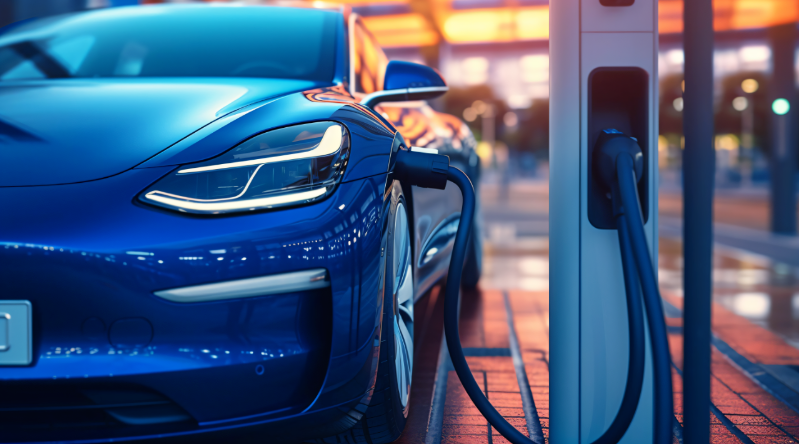In Norway, for every 100 new cars sold, 97 are electric vehicles. This latest data from the Norwegian Road Federation (OFV) not only breaks its own record but also serves as a 'litmus test' for Chinese brands accelerating their overseas expansion. As of June, the market share of electric vehicles reached a staggering 97%, setting a new global record. The overall electric vehicle market share for the first half of the year stood at 93.7%, reflecting an increase of 8.8 percentage points year-on-year, as traditional fuel vehicles are nearly completely replaced. Factors such as zero-interest financing, central bank interest rate cuts lowering consumer barriers, and long-term incentives like VAT exemptions and road priority have driven rapid sales growth. In June, Norway registered 18,373 passenger cars, a 4.9% increase compared to the previous year, with total sales for the first half of the year reaching 75,515 units, an increase of 23% year-on-year. Chinese brands accounted for a record 12.3% of new car sales in Norway during the first half, nearly double the 7% seen in 2023. Four Chinese brands—Polestar, BYD, MG, and XPeng—were among the top 15 best-selling car brands in Norway in June. The total sales of pure electric vehicles in Norway reached 17,799 units in June, a significant year-on-year increase of 27%. This record market share was largely driven by the substantial deliveries of the Tesla Model Y, which saw a 115.3% year-on-year surge, resulting in a 54% year-on-year increase in Tesla's new car sales in Norway. Unlike Tesla's performance in other European regions, such as a 60% decline in sales in Germany, the Model Y’s competitive pricing has met local demands for spacious storage, high ground clearance, all-wheel drive, and towing capabilities, making it a 'value-for-money' vehicle for consumers. The Model Y sold 5,004 units in June, capturing a market share of 27.2%, making it the best-selling electric vehicle in Norway. The second and third best-sellers were Toyota's bZ4x and Volkswagen's ID.4, with sales of 825 and 714 units, respectively, holding market shares of 4.5% and 3.9%. BYD's Sealion 7 (domestic model Hai Nao 07EV) achieved sales of 604 units, with a market share of 3.3%, marking a significant breakthrough for BYD in the European market by entering the top 5 for the first time. Volvo, under Geely, also entered the top 15 with models like EX30, EX40, EX90, and Polestar 3. The performance of Chinese brands among the top 15 best-selling car brands in June indicates a deepening market presence and growing recognition. BYD ranked 8th with 754 units sold, a market share of 4.1%, reflecting a staggering year-on-year growth of 450%. MG sold 475 units for a market share of 2.6%, ranking 12th. XPeng, driven by its G6 and G9 models, sold 346 units, a year-on-year increase of 236%, with a market share of 1.9%, placing it 14th. The combination of Volvo EX30 and Polestar 3 contributed 1,851 units in the first half of the year, showcasing the influence of Chinese brands in the high-end market. Expanding the timeline to the first half of 2025, BYD sold 2,411 units with a 3.2% market share, ranking 12th, while MG sold 1,966 units for a 2.6% market share, securing the 13th position. Polestar sold 1,851 units with a 2.5% market share, ranking 14th, and new player XPeng achieved 1,667 units sold for a 2.2% market share, placing 15th. Øyvind Solberg Thorsen, the director of OFV, noted that Norwegian consumers choose car brands based on personal preferences and economic capabilities. As long as consumers recognize the vehicle, its price, and its ability to meet requirements for space, configuration, and range, they will choose that model, showing low loyalty to brands and models. The highly electrified, policy-friendly, and mature Norwegian market provides a 'stress test' level of overseas trial for Chinese electric vehicle brands. Brands like BYD and XPeng have gradually established a foothold, validating that Chinese electric vehicles possess the capability to compete on par with global giants in terms of technology, product, and operation. However, the relatively small scale of the Norwegian market and its high policy dependency mean its success model cannot be simply replicated in other parts of Europe. For Chinese brands aiming at the entire European market, the real challenge lies in how to elevate the 'Norwegian logic' to a 'European strategy', requiring localizing the supply chain, exporting technical standards, and fostering cross-brand collaboration amidst the complex policies and cultural differences in Europe to carve out a sustainable path for localized development.
Norway Sets New Record with 97% Electric Vehicle Sales

Images

Share this post on: